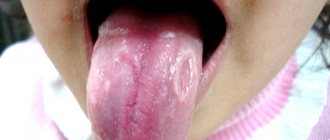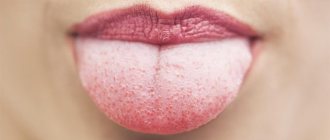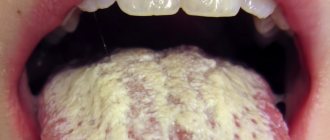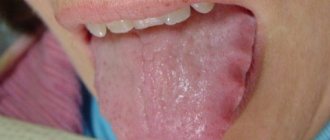Structure and functions
The tongue is a muscular organ without bones, covered with a mucous membrane.
Main functions:
- is directly involved in the pronunciation of sounds;
- determines the taste of what a person eats and drinks;
- is an integral element of the digestive system - it carries out the primary processing of food before it enters the esophagus.
The structure of the organ is quite simple, but very interesting. The tongue is divided into two parts: the back - the root and the front - the body or, as it is also called, the back, which has a velvety structure. The top is covered with papillae, which are responsible for taste buds.
Diagnostic Tool
The language, whose structure is complex, is an indicator of the state of the body. The following diseases are suggested by their appearance:
- yellow plaque indicates gastrointestinal diseases;
- trembling of the tip is a sign of neuroses, diseases of the nervous system;
- cracks are a symptom of digestive pathologies;
- deepening of the furrow is a symptom of a back problem;
- metabolic disorders - dry mucosa;
- light ulcers occur with gastritis, accompanied by high acidity;
- a bright, shiny surface is a sign of high temperature, infection;
- white plaque signals candidiasis and stomatitis.
A healthy back is smooth, velvety, pale pink in color. It does not leave the teeth, is moist, and has an even, straight central groove. Plaque appears due to anaerobic bacteria accumulating on the mucous membrane. An effective remedy is daily brushing with a toothbrush.
Sources:
- Kurepina M.M., Ozhigova A.P., Nikitina A.A. Human anatomy. Moscow, 2010.
- Fed.kovich N. Anatomy and physiology of man. Tutorial. Rostov-on-Don, 2003.
What a healthy tongue should look like
A healthy tongue should be pink and have a fold along its surface. It should be soft upon palpation and should not hurt when moving in different directions. The taste buds on the organ should be clearly visible. A small amount of white plaque does not always indicate the presence of any pathology; as a rule, this is the norm. A significant accumulation of plaque on the tongue may indicate the development of the following diseases:
- caries;
- gingivitis and other periodontal diseases;
- candidiasis.
Also, the cause of white or yellow plaque can be gastrointestinal diseases, food allergies or lack of vitamins. Plaque thickening may signal a chronic disease.
How to spot early symptoms of tongue cancer
20.06.18
The fear of getting cancer is quite common and is called cancerophobia, or less commonly, cancrophobia. I would say, given the inclusion of cancer in the top five most common causes of death, that this fear is quite constructive if it prompts you to avoid risk factors and be regularly examined by an oncologist. This is good form - modern and responsible.
Tongue cancer is less common than many other types of cancer, but the fear of it is great due to the expected disability and significant impairment of quality of life.
What needs to be done to catch it at an early stage, at which it is possible to do without crippling methods of treatment?
Tongue cancer is insidious - its early manifestations are masked by harmless symptoms and require an active search even with regular examination. The greatest likelihood of detecting the first symptoms occurs during a regular dentist appointment. Firstly, he knows well what a healthy tongue should look like, and secondly, he knows what to do if he suspects the onset of a disease. It is important to understand that the dentist will notice early symptoms if you ask about it at the appointment, present complaints or concerns. If dangerous symptoms are detected, the dentist is obliged to refer the patient to an oncologist.
Particular attention to the tongue and oral cavity should be given to smokers, people working with carcinogens - asbestos, perchlorethylene, petroleum products and heavy metal salts. The second place among the risk factors for developing tongue cancer is microtrauma from sharp edges of teeth, poorly fitting dentures and fillings. The so-called precancerous diseases and conditions are important - erosion of the tongue, leukoplakia, papillomas, hyperkeratic and ulcerative-erosive forms of systemic lupus erythematosus and lichen planus, Bowen's disease.
Men suffer from tongue cancer 6-7 times more often than women. The reasons for this are poorly understood, it is assumed that they are more likely to be exposed to harmful factors, but it is possible that cancer is inherited on the Y chromosome.
Most often the lateral surface of the tongue is affected, less often the root or bottom of the tongue, and least often the surface. The tip of the tongue accounts for only 3% of identified cases. To identify tongue cancer at an early stage, let’s remember its three main manifestations:
- the presence of papillary growths or whitish spots, compactions or redness on the tongue, special attention to the lateral surfaces!
- enlargement of the submandibular lymph nodes
- soreness in the tongue without clear localization. This symptom is rare, more often it is simply a feeling of discomfort, an unusual sensation in the tongue.
At this stage, the oncologist will do a smear test or biopsy to identify the type of cancer or rule it out. By the way, for the initiated, in 95% of histologically, tongue cancer is classified as squamous, i.e. develops rapidly and metastasizes quickly.
At the second stage, it is called “developed”, the symptoms are more distinct, but the treatment prognosis is worse.
- the pain becomes more localized, radiating to the ear, temple or oral organs
- salivation increases
- there will be a bad breath
- There is numbness in parts of the tongue, difficulty pronouncing sounds, pain when swallowing
- with the papillary form, a distinct growth will appear on the tongue (see illustration), with the ulcerative form, a growing ulcer with a distinct ridge along the edges (also shown in the illustration)
- in the infiltrative-ulcerative form, deep fissure ulcers appear on the tongue; in the infiltrative form, the body of the tongue thickens
The advanced stage is quite obvious and we will not consider it within the scope of this material.
Treatment for tongue cancer is always complex, including surgery, radiation therapy and chemotherapy. Prevention consists of quitting smoking, limiting alcoholic beverages, and regular dental and oral care.
Timely diagnosis allows for a favorable survival prognosis, which some authors note at 95%. But here, the sooner the patient applies, the better the prognosis. Attention to health, accuracy and systematic reasonable self-observation can give many years of active life.
Differences by color
Many people know that by the color of the tongue one can understand that something is wrong with the body. It is not a myth that some diseases are reflected on the tongue by a characteristic shade of plaque.
Let's look at the most common ones:
- influenza accompanied by high body temperature - burgundy coating;
- heart problems, anemia, malnutrition – pale color;
- blood diseases and pathologies of the respiratory system - purple tint;
- gastrointestinal diseases, jaundice or smoking - gray or yellow color;
- problems with the liver or spleen, dysentery, advanced viral diseases, abscess - black plaque;
- kidney pathologies – bluish tint;
- circulatory disorders, heavy metal poisoning – blue color;
- fungal infection and general dehydration of the body - white plaque;
- dental diseases – whitish or dark brown color.
Tongue color
Pale white tongue
A white or pale tongue is most likely a sign of problems related to the digestive system. This color of the organ is often accompanied by loose stools, cold hands or feet, fatigue or bloating.
An extremely pale, dry tongue may also indicate a blood deficiency, which is usually accompanied by anxiety, dizziness, memory loss, insomnia, chapped lips or anemia.
Red tongue
A bright red tongue almost always indicates an infection in the body. Red dots on the tongue may indicate temperature or inflammation in the blood. Children may develop an immune response to infection in this way. Dark red color is a sign of kidney problems or intoxication of the body.
Red tipped tongue
The tip of the tongue is also known as the heart area. Given this fact, a red tip of the tongue without any signs of illness may indicate emotional turmoil.
Tongue, red around the edges
This color of the tongue indicates excessive consumption of spicy or fatty foods, as well as alcohol. According to Eastern medicine, the result of long-standing anger or resentment can manifest itself in the same way.
Purple tongue
Most often, this color is caused by a deficiency of vitamin B2. It can also occur in women who have very difficult menstrual cycles or in people experiencing chronic pain.
Blue tongue
If your tongue is blue, this is a signal to urgently consult a doctor. It indicates that insufficient oxygen is reaching the tissues. It may also be a sign of developing heart disease, damaged blood vessels, or dysfunction of the heart or respiratory tract.
Yellow tongue
If the yellowness of the tongue does not go away for a long time, then it is a sign of liver or gall bladder disease. The front part of the tongue is yellow - a sure sign of hepatitis.
Plaque in a child
In a child's first months of life, the appearance of white, loose plaque is a sign of oral candidiasis. This disease is caused by fungi of the genus Candida. Infection occurs already in the first hours of a newborn’s life, and according to some authors, intrauterine transmission of infection from mother to fetus is also possible. Most often, infection occurs during childbirth. This is due to the fact that in the third trimester of pregnancy, Candida fungi are sown from the vaginal mucosa in 30–86% of women³.
Oral candidiasis is often called “thrush”. The disease received its name for the characteristic appearance of plaque, which resembles droplets of curdled milk or small curd grains.
Candidiasis can also occur in older children, adolescents and even adults. The reason for its development, in addition to infection, is a significant decrease in the body's defenses - immunodeficiency states.
Tongue is like a rainbow
In children, plaque can be not only white, but also colored.
Sometimes it is provoked by completely harmless reasons. Fruits and berries contain coloring pigments, while caramel and soda contain dyes. They are able to give the mucous membrane different colors - red, blue, green, purple, yellow. Therefore, if a child has this color of tongue, do not immediately panic. It is better to remember what foods he consumed during the last hours. But if the colored plaque persists for several days or occurs repeatedly, you should definitely show the child to the pediatrician. With the onset of puberty in adolescents, hormonal status changes dramatically. This creates the preconditions for a decrease in local immunity in the oral cavity, which causes the proliferation of bacterial flora. It is deposited on the tongue in the form of plaque.









